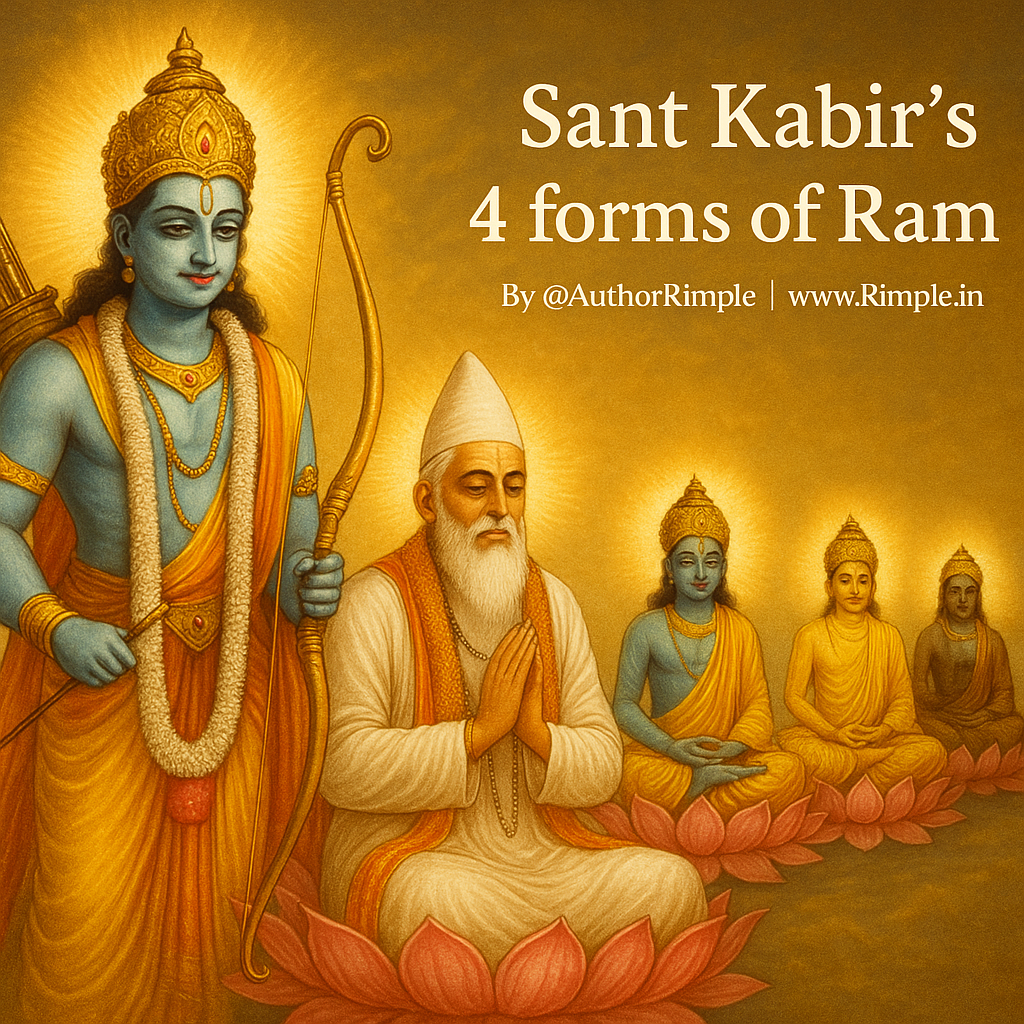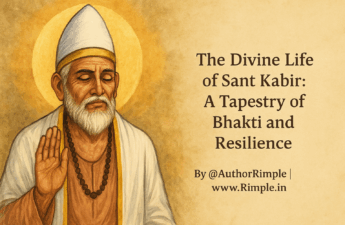In the sacred realm of Indian spirituality, Sant Kabir’s voice rises like a celestial song, its simplicity piercing the veil of illusion to reveal the radiant truth of Ram. His dohas, like lotus petals floating on the river of divinity, carry the essence of the eternal, inviting every heart to awaken. For Kabir, Ram is not merely the historical Bhagwan Shri Ram but the infinite divine, shimmering in four exquisite forms: Nirgun Ram (the formless divine), Sagun Ram (the divine with attributes), Ram as the human incarnation (Shri Ram of Ayodhya), and Ram as the inner self (the divine spark within). These forms are not separate but interwoven threads of a single divine tapestry, each leading to the same truth. Through Kabir’s luminous dohas, penned in the sacred Devanagari script, let us embark on a poetic pilgrimage—a journey that stirs the soul, evokes awe, and whispers, “Ram is everywhere, Ram is you.”
The Four Forms of Ram: A Celestial Dance
Kabir’s vision of Ram is like a diamond, reflecting divine light in four breathtaking facets. Each form is a portal to the infinite, yet each speaks to us in a language we can understand—simple, profound, and drenched in love. Let us immerse ourselves in these forms, guided by Kabir’s dohas, and feel the divine embrace that transforms our hearts.
1. Nirgun Ram: The Formless Infinite
Nirgun Ram is the boundless, formless divine—the eternal essence beyond name, shape, or thought. Imagine the vast sky, holding every star yet untouched by them; this is Nirgun Ram, the source of all creation, unseen yet ever-present. Kabir calls us to seek this divine beyond the senses, in the silent depths of the heart.
दोहा:
एक राम को सकल परासा, एक राम त्रिभुवन से न्यारा।
एक राम दशरथ का बेटा, एक राम घट-घट में बैठा।
Translation:
One Ram is the essence of all creation, one Ram is beyond the three worlds.
One Ram is Dasharatha’s son, one Ram resides in every heart.
Explanation:
In this radiant doha, Kabir unveils the four forms of Ram with poetic grace. Nirgun Ram is the “Ram tribhuvan se nyara”—the divine beyond the three worlds (physical, astral, and causal), untouched by form or limitation. Like the invisible wind that stirs the leaves, this Ram is the formless truth that permeates all existence. Kabir urges us to look beyond the tangible, to seek the divine that is infinite yet intimate, dwelling in the heart’s quiet core.
Another doha deepens this mystery:
दोहा:
कस्तूरी कुंडल बसे, मृग ढूंढे बन माहि।
ऐसे घट-घट राम हैं, दुनिया देखे नाही।
Translation:
The musk deer searches the forest for the fragrance within itself.
So too, Ram resides in every heart, yet the world fails to see.
Explanation:
Kabir paints a vivid analogy: the musk deer chases its own scent, unaware it lies within. Similarly, we wander temples and shrines, seeking Nirgun Ram, who is already within us. This doha is a divine whisper, urging us to pause, turn inward, and discover the formless Ram that sparkles in our soul like a hidden star.
2. Sagun Ram: The Divine Embraced in Love
Sagun Ram is the divine adorned with attributes—loving, compassionate, and accessible through devotion. This is Ram as the deity we worship, the one who responds to our prayers with grace. Picture the sun’s rays warming the earth: the sun is vast, but its light touches us gently. So too, Sagun Ram is the divine made relatable through love and devotion.
दोहा:
राम बुलावा भेजिया, दीया कबीरा रोय।
जो सुख साधु संग में, सो बैकुंठ न होय।
Translation:
Ram sent an invitation, and Kabir weeps with joy.
The bliss of saints’ company surpasses even heaven’s joy.
Explanation:
Kabir’s heart sings of Sagun Ram as the divine who lovingly calls us, like a mother beckoning her child home. This invitation comes through devotion, chants, or the company of saints, where the heart feels Ram’s presence as a flood of bliss. This doha is a love letter from the divine, reminding us that Sagun Ram is near, waiting to embrace us through heartfelt worship.
Another doha amplifies this:
दोहा:
साईं सोई सतगुरु, जो राम नाम संन्यास।
सतगुरु बिन सुख नाही, ज्यों दीपक बिन प्रकाश।
Translation:
The true Guru teaches devotion to Ram’s name.
Without the Guru, there’s no peace, like a lamp without light.
Explanation:
Kabir likens Sagun Ram to a lamp’s glow, kindled by the Guru who guides us to chant Ram’s name with love. This chanting is not mere words but a bridge to the divine’s qualities—mercy, love, and grace. Like a melody that stirs the soul, Sagun Ram fills our hearts with divine sweetness.
3. Ram as the Human Incarnation: The Divine Exemplar
Ram as the human incarnation is Lord Rama, the prince of Ayodhya, whose life in the Ramayana shines as a beacon of righteousness, duty, and compassion. This Ram is the divine in human form, walking among us to show the path of virtue. Imagine a lighthouse guiding ships through stormy seas—Rama’s life is that steady light, inspiring us to live with truth and love.
दोहा:
एक राम दशरथ का बेटा, एक राम घट-घट में बैठा।
एक राम को सकल परासा, एक राम त्रिभुवन से न्यारा।
Translation:
One Ram is Dasharatha’s son, one Ram resides in every heart.
One Ram is the essence of all, one Ram is beyond the three worlds.
Explanation:
Here, Kabir points to Ram as Dasharatha’s son—the historical Rama, whose life of sacrifice, loyalty, and dharma is a divine blueprint for humanity. Like a hero whose story inspires generations, Lord Rama shows us how to live with integrity, honoring our duties while remaining anchored in love. This Ram is not distant but a living ideal, guiding us like a star in the night sky.
Another doha reflects this inspiration:
दोहा:
राम रमैया घर में, तज दे देह गुमान।
जो सिस झुके राम में, ताके सदा कल्याण।
Translation:
Ram, the divine, resides in your home; abandon bodily pride.
The one who bows to Ram finds eternal welfare.
Explanation:
Kabir sees Lord Rama as a guest in our heart’s home, urging us to shed ego (deh guman) and emulate his virtues. Bowing to Rama means living his values—truth, humility, and compassion. Like a child learning from a wise elder, we find peace by following Rama’s path, which leads to eternal well-being.
4. Ram as the Inner Self: The Divine Within
The most profound of Kabir’s revelations is Ram as the inner self—the divine spark within every soul, the eternal consciousness that is our true essence. This Ram is not outside but within, like a seed hidden in a fruit, waiting to bloom into realization. Kabir’s words here are a divine mirror, reflecting our own divinity back to us.
दोहा:
तीन राम को सब कोई धयावे, चतुर्थ राम को मर्म न पाने।
चौथा छाड़ि जो पंचम धयावे, कहे कबीर सो हम को पावे।
Translation:
Everyone worships the three Rams, but the fourth Ram’s secret eludes them.
Abandoning the fourth to seek a fifth, Kabir says, only finds me.
Explanation:
Kabir reveals that while people worship the three forms of Ram—Sagun, Nirgun, and the human incarnation—the fourth Ram, the divine within, remains unknown to most. Chasing a “fifth” Ram (external illusions or false gods) leads nowhere. The chaturth Ram is the divine self, the essence of “I am.” Like a treasure buried in your own home, this Ram is found through self-realization, and Kabir, with a twinkle of divine mischief, says, “Find this Ram, and you find me—your true self.”
Another doha unveils this truth:
दोहा:
मोको कहां ढूंढे रे बंदे, मैं तो तेरे पास।
ना मैं मंदिर, ना मैं मस्जिद, ना काबे कैलास।
Translation:
Where do you search for me, O seeker? I am right beside you.
Not in temples, mosques, or sacred mountains.
Explanation:
This doha is a thunderbolt of divine clarity. Kabir declares that Ram is not in external places but within, as close as your breath. Like searching for your shadow while standing in the sun, we seek God outside, unaware that Ram is our very soul. Kabir’s words are a loving nudge to awaken, to see the divine spark that makes us whole.
The Symphony of Ram
Kabir’s four forms of Ram are not separate but a divine symphony, each note harmonizing with the others. Nirgun Ram is the infinite ocean, Sagun Ram the waves that kiss the shore, Ram as the human incarnation the lighthouse guiding us home, and Ram as the inner self the pearl within our heart. Together, they weave a path from devotion to realization, from the external to the eternal.
दोहा:
राम रहीम एक हैं, नाम धराया दोय।
कह कबीर सुन मेरे, प्रेम बिना सब खोय।
Translation:
Ram and Rahim are one, only their names are two.
Kabir says, listen to me: without love, all is lost.
Explanation:
Kabir’s final note is a hymn of unity. Whether called Ram, Rahim, or any name, the divine is one. The essence of all four forms is love—love that chants Sagun Ram, seeks Nirgun Ram, follows Lord Rama, and discovers the divine within. Without love, life is an empty song. This doha is a divine embrace, uniting all paths in the heart’s devotion.
A Divine Awakening
Kabir’s dohas are not mere words—they are celestial sparks, igniting the soul with wonder and reverence. His four forms of Ram are a sacred invitation to see the divine in every breath, every moment, every self. Reading his dohas is like gazing into a cosmic mirror, where we see not just ourselves but the eternal Ram shining back. Let us chant Ram, live Ram, and become Ram—for in Kabir’s poetic wisdom, the divine is not a distant star but the very light within us, whispering, “You are home.”
Final Doha:
जप राम, तप राम, राम ही सन्यास।
कह कबीर सुन मेरे, राम बिना ना उदास।
Translation:
Chant Ram, meditate on Ram, Ram is true renunciation.
Kabir says, listen to me: without Ram, there is only despair.
Explanation:
Kabir’s parting words are a divine crescendo. Whether through chanting (Sagun), meditation (Nirgun), emulating Rama’s life, or realizing the inner self, Ram is the heart of all spiritual paths. Without this connection, life is a shadow. With Ram, every moment sparkles with divinity, leaving our hearts singing, “Wow!” as we dissolve into the eternal embrace of the divine.
Also Read:





